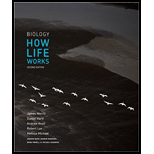
Concept explainers
To determine:
The product and density of DNA after one and two rounds of replication if Meselson and Stahl had started their experiment with 14N light DNA and then transferred them into 15N heavy DNA medium.
Concept introduction:
Meselson and Stahl performed an experiment to prove that DNA (deoxyribonucleic acid) replicates in a semi-conservative manner. They first grew bacterial cells in 15N medium, so that the DNA of the bacterial cells would only contain pure 15N DNA. Afterwards, these cells were transferred into 14N medium.
After one round of replication, DNA was centrifuged to observe their density in a solution containing cesium chloride. The density of parental DNA (15N/15N) was found to be
Explanation of Solution
If Meselson and Stahl would have performed their experiment the other way around, the observations would have been different, but would definitely suggest the same thing that DNA replication takes place in a semi-conservative manner. If they would have first grown bacterial cells in 14N medium and then transferred these cells into 15N medium, DNA hybrids containing 14N/15N would have been formed after one round of replication. Their density is supposed to be
DNA replication is the process of the duplication of DNA. This process takes place in a semi-conservative manner, where one of the strands is parental and the other is newly synthesized.
Want to see more full solutions like this?
Chapter 12 Solutions
Biology: How Life Works - Standalone book
 Human Anatomy & Physiology (11th Edition)BiologyISBN:9780134580999Author:Elaine N. Marieb, Katja N. HoehnPublisher:PEARSON
Human Anatomy & Physiology (11th Edition)BiologyISBN:9780134580999Author:Elaine N. Marieb, Katja N. HoehnPublisher:PEARSON Biology 2eBiologyISBN:9781947172517Author:Matthew Douglas, Jung Choi, Mary Ann ClarkPublisher:OpenStax
Biology 2eBiologyISBN:9781947172517Author:Matthew Douglas, Jung Choi, Mary Ann ClarkPublisher:OpenStax Anatomy & PhysiologyBiologyISBN:9781259398629Author:McKinley, Michael P., O'loughlin, Valerie Dean, Bidle, Theresa StouterPublisher:Mcgraw Hill Education,
Anatomy & PhysiologyBiologyISBN:9781259398629Author:McKinley, Michael P., O'loughlin, Valerie Dean, Bidle, Theresa StouterPublisher:Mcgraw Hill Education, Molecular Biology of the Cell (Sixth Edition)BiologyISBN:9780815344322Author:Bruce Alberts, Alexander D. Johnson, Julian Lewis, David Morgan, Martin Raff, Keith Roberts, Peter WalterPublisher:W. W. Norton & Company
Molecular Biology of the Cell (Sixth Edition)BiologyISBN:9780815344322Author:Bruce Alberts, Alexander D. Johnson, Julian Lewis, David Morgan, Martin Raff, Keith Roberts, Peter WalterPublisher:W. W. Norton & Company Laboratory Manual For Human Anatomy & PhysiologyBiologyISBN:9781260159363Author:Martin, Terry R., Prentice-craver, CynthiaPublisher:McGraw-Hill Publishing Co.
Laboratory Manual For Human Anatomy & PhysiologyBiologyISBN:9781260159363Author:Martin, Terry R., Prentice-craver, CynthiaPublisher:McGraw-Hill Publishing Co. Inquiry Into Life (16th Edition)BiologyISBN:9781260231700Author:Sylvia S. Mader, Michael WindelspechtPublisher:McGraw Hill Education
Inquiry Into Life (16th Edition)BiologyISBN:9781260231700Author:Sylvia S. Mader, Michael WindelspechtPublisher:McGraw Hill Education





